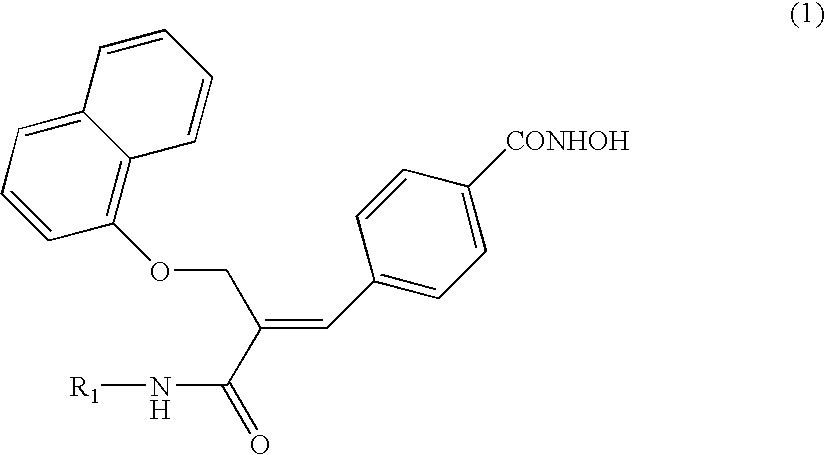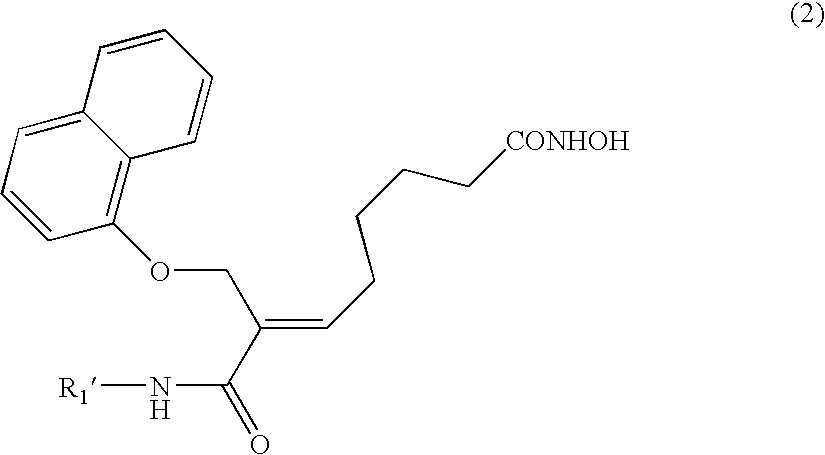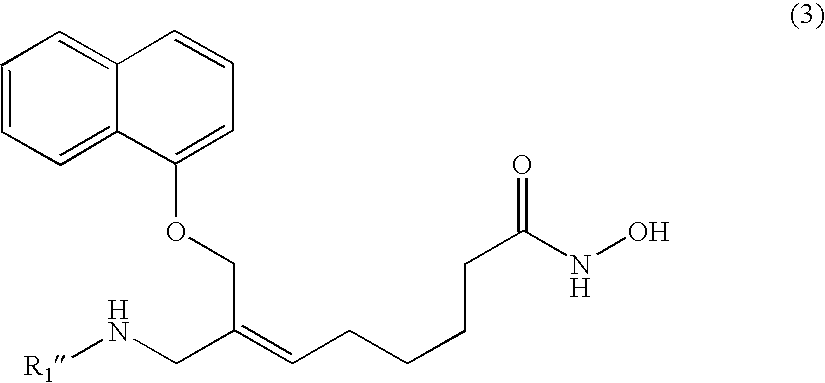Naphthalenyloxypropenyl derivatives having inhibitory activity against histone deacetylase and pharmaceutical composition comprising the same
a technology of histone deacetylase and derivatives, which is applied in the direction of drug compositions, heterocyclic compound active ingredients, biocide, etc., can solve the problems of normal cells becoming cancer and unsuitable for the analysis of hdac inhibitors, and achieve the effect of suppressing tumor cell proliferation and efficient inhibition of histone deacetylase activity
- Summary
- Abstract
- Description
- Claims
- Application Information
AI Technical Summary
Benefits of technology
Problems solved by technology
Method used
Image
Examples
preparation example 1-1
Preparation of t-butyl-3-hydroxy-2-methylene-3-(4-methoxycarbonylphenyl)propanoate (the compound of formula II)
[0238]4-(methoxycarbonyl)benzaldehyde (3.3 g, 20 mM), t-butylacrylate (3.5 ml, 24 mM) and 1,4-diazabicyclo[2,2,2]octane (449 mg, 4 mM) were mixed and stirred in a vessel at room temperature for 5 days. The resulting mixture was extracted with ethyl ether. The organic layer was separated, washed with 2N hydrochloric acid, water and an aqueous sodium bicarbonate solution in order, dried over anhydrous sodium sulfate, filtered and concentrated under reduced pressure. The residue thus obtained was subjected to a silica gel column chromatography (eluent: ethyl acetate / n-hexane=1 / 19), to obtain 4.1 g of the title compound as a white solid (yield 73%).
[0239]1H-NMR (200 MHz, CDCl3) δ 1.40 (s, 9H), 3.28 (m, 1H), 3.91 (s, 3H), 5.53 (d, 1H, J=5.2 Hz), 5.71 (s, 1H), 6.27 (s, 1H), 7.45 (d, 2H, J=8.0 Hz), 7.82 (d, 2H, J=8.0 Hz);
[0240]MS (EI, 70 eV) m / z 292 (M+), 278, 239, 220, 187, 124, ...
preparation example 1-2
Preparation of Methyl 4-(3-bromo-2-t-butoxycarbonylpropenyl)benzoate (the compound of formula III)
[0242]t-Butyl-3-hydroxy-2-methylene-3-(4-methoxycarbonylphenyl)-propanoate (994 mg, 3.4 mM) obtained in Preparation Example 1-1 was dissolved in ethyl ether (10 ml), and cooled to 0° C. To the resulting mixture, tribromophosphine (0.35 ml, 3.74 mM) was slowly added and stirred at room temperature for 1 hr. After the completion of reaction, the reaction mixture was cooled to −10° C. with adding ice water and extracted with ethyl ether.
[0243]The organic layer was separated, washed with brine, dried over anhydrous MgSO4, filtered, and concentrated under reduced pressure. The residue thus obtained was subjected to a silica gel column chromatography (eluent: ethyl acetate / n-hexane=1 / 9), to obtain 831 mg of the title compound as a yellowish green solid (yield 71%).
[0244]1H-NMR (300 MHz, CDCl3) δ 1.40 (s, 9H, OCH3), 3.88 (s, 3H, OCH3), 3.97 (s, 2H, CH2), 7.41 (d, 2H, J=8.4 Hz, ArH), 7.50 (s, 1...
preparation example 1-3
Preparation of methyl 4-[3-(naphthalen-1-yloxy)-2-t-butoxycarbonylpropenyl]benzoate (the compound of formula IV)
[0247]Methyl 4-(3-bromo-2-t-butoxycarbonylpropenyl)benzoate (355 mg, 1.00 mM) obtained in Preparation Example 1-2 was dissolved in acetone (5 ml), and potassium carbonate (207 mg, 1.50 mM) and 1-naphthalenol (144 mg 1.00 mM) were added thereto. The resulting mixture was heated to reflux for 3 hrs. After the completion of reaction, the solvent of the reaction mixture was removed at room temperature under reduced pressure. The residue thus obtained was purified with a silica gel column chromatography (eluent: ethyl acetate / n-hexane=1 / 9) to obtain 441 mg of the title compound as a white solid (yield 100%).
[0248]1H-NMR (200 MHz, CDCl3) δ 1.49 (s, 9H, CH3), 3.89 (s, 3H, OCH3), 4.96 (s, 2H, CH2), 6.84 (d, 1H, J=7.33 Hz, ArH), 7.53 (m, 5H, ArH), 7.89 (m, 1H, ArH), 8.01 (m, 3H, ArH), 8.24 (m, 3H, ArH).
PUM
| Property | Measurement | Unit |
|---|---|---|
| Volume | aaaaa | aaaaa |
| Molar density | aaaaa | aaaaa |
| Molar density | aaaaa | aaaaa |
Abstract
Description
Claims
Application Information
 Login to View More
Login to View More - R&D
- Intellectual Property
- Life Sciences
- Materials
- Tech Scout
- Unparalleled Data Quality
- Higher Quality Content
- 60% Fewer Hallucinations
Browse by: Latest US Patents, China's latest patents, Technical Efficacy Thesaurus, Application Domain, Technology Topic, Popular Technical Reports.
© 2025 PatSnap. All rights reserved.Legal|Privacy policy|Modern Slavery Act Transparency Statement|Sitemap|About US| Contact US: help@patsnap.com



